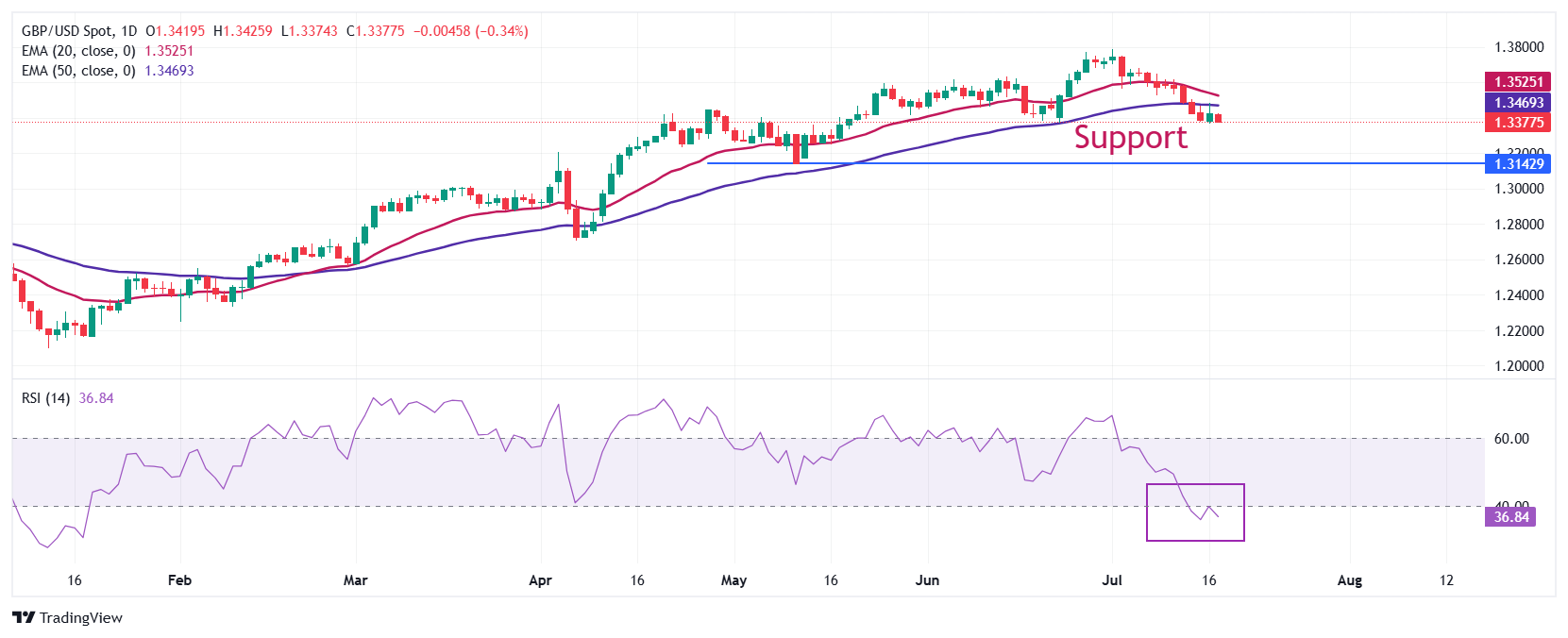Pound Sterling declines against US Dollar after UK employment data
- The Pound Sterling declines against the US Dollar on mixed UK employment data for the three-months ending May.
- UK wage growth slowed down, as expected, and the ILO Unemployment Rate accelerated to 4.7%.
- US President Trump denied reports stating that he will fire Fed’s Powell soon.
The Pound Sterling (GBP) declines against the US Dollar (USD) on Thursday, trading below 1.3400, as the United Kingdom (UK) Office for National Statistics has reported mixed employment data. The report showed that the number of workers added by employers in the three-months ending May came in higher at 134K than the prior reading of 89K. However, the ILO Unemployment Rate has increased to 4.7%, above expectations and the prior reading of 4.6%.
Investors were anticipating a weak set of employment numbers as the latest survey from the Recruitment and Employment Confederation trade body and accountants KPMG signaled that the availability of individuals for jobs has increased significantly.
The hiring had been slowed down in recent months as business owners were offsetting the impact of an increase in employers’ contribution to social security schemes announced by the Chancellor of the Exchequer in the Autumn Statement.
Average Earnings (Excluding and Including) bonuses rose by 5% on year, majorly in line with market expectations, but have slowed down from readings seen in the three-months ending April.
Easing Average Earnings, a key measure of wage growth, is expected to offer slight relief to Bank of England (BoE) officials, who have become worried about the inflation outlook, following the release of the hotter-than-projected Consumer Price Index (CPI) report on Wednesday. The report showed that both headline and the core CPI rose at a faster pace on year to 3.6% and 3.7%, respectively.
British Pound PRICE Today
The table below shows the percentage change of British Pound (GBP) against listed major currencies today. British Pound was the strongest against the Australian Dollar.
| USD | EUR | GBP | JPY | CAD | AUD | NZD | CHF | |
|---|---|---|---|---|---|---|---|---|
| USD | 0.51% | 0.30% | 0.51% | 0.33% | 0.90% | 0.54% | 0.47% | |
| EUR | -0.51% | -0.21% | -0.02% | -0.15% | 0.41% | 0.06% | -0.01% | |
| GBP | -0.30% | 0.21% | 0.24% | 0.03% | 0.60% | 0.26% | 0.18% | |
| JPY | -0.51% | 0.02% | -0.24% | -0.23% | 0.34% | 0.03% | -0.05% | |
| CAD | -0.33% | 0.15% | -0.03% | 0.23% | 0.65% | 0.22% | 0.14% | |
| AUD | -0.90% | -0.41% | -0.60% | -0.34% | -0.65% | -0.43% | -0.42% | |
| NZD | -0.54% | -0.06% | -0.26% | -0.03% | -0.22% | 0.43% | -0.07% | |
| CHF | -0.47% | 0.01% | -0.18% | 0.05% | -0.14% | 0.42% | 0.07% |
The heat map shows percentage changes of major currencies against each other. The base currency is picked from the left column, while the quote currency is picked from the top row. For example, if you pick the British Pound from the left column and move along the horizontal line to the US Dollar, the percentage change displayed in the box will represent GBP (base)/USD (quote).
Daily digest market movers: Pound Sterling weakens against US Dollar
- The Pound Sterling is down 0.25% against the US Dollar on Thursday, trading close to an almost two-month low around 1.3360. The GBP/USD pair is under pressure due to deteriorating UK labor market conditions and a firm US Dollar.
- At the time of writing, the US Dollar Index (DXY), which tracks the Greenback’s value against six major currencies, trades 0.5% higher to near 98.80.
- The US Dollar gains as United States (US) President Donald Trump has denied reports stating that he will fire Federal Reserve (Fed) Chair Jerome Powell. However, Trump continued to criticize him for not lowering interest rates.
- US President Trump acknowledged in an interview with the Real America’s Voice network on Wednesday that Powell’s dismissal by him could cause upheaval in markets. "I’d love if he wants to resign, that would be up to him. They say it would disrupt the market if I did," Trump said.
- The report from Reuters on Wednesday stating that Trump received a positive response after polling some Republican lawmakers on firing Powell led to a sharp decline in the US Dollar and US equity markets.
- Meanwhile, comments from a couple of Fed officials pointing to de-anchoring consumer inflation expectations have also strengthened the US Dollar. New York Federal Reserve (Fed) Bank President John Williams and Atlanta Fed Bank President Raphael Bostic warned that the impact of tariffs on inflation has just started building up, and it will accelerate going ahead.
- “It's early days for impact of tariffs on economy, which is modest so far but will increase over time,” New York Fed Bank President John Williams said in a speech at the New York Association for Business Economics on Wednesday. He warned that tariffs should boost inflation by “one percentage point rest of 2025 into 2026”.
- Going forward, investors will focus on the US Retail Sales data, a key indicator of consumer spending, for June, which will be published at 12:30 GMT. The consumer spending measure is expected to have grown by 0.1% after declining 0.9% in May.
Technical Analysis: Pound Sterling trades below 1.3400

The Pound Sterling declines to near 1.3370 against the US Dollar, the lowest level in almost two months. The near-term trend of the GBP/USD pair is bearish as it trades below the 20-day and 50-day Exponential Moving Averages (EMAs), which trade around 1.3525 and 1.3470, respectively.
The 14-day Relative Strength Index (RSI) oscillates below 40.00, indicating a strong bearish momentum.
Looking down, the May 12 low of 1.3140 will act as a key support zone. On the upside, the July 11 high around 1.3585 will act as a key barrier.
Pound Sterling FAQs
The Pound Sterling (GBP) is the oldest currency in the world (886 AD) and the official currency of the United Kingdom. It is the fourth most traded unit for foreign exchange (FX) in the world, accounting for 12% of all transactions, averaging $630 billion a day, according to 2022 data. Its key trading pairs are GBP/USD, also known as ‘Cable’, which accounts for 11% of FX, GBP/JPY, or the ‘Dragon’ as it is known by traders (3%), and EUR/GBP (2%). The Pound Sterling is issued by the Bank of England (BoE).
The single most important factor influencing the value of the Pound Sterling is monetary policy decided by the Bank of England. The BoE bases its decisions on whether it has achieved its primary goal of “price stability” – a steady inflation rate of around 2%. Its primary tool for achieving this is the adjustment of interest rates. When inflation is too high, the BoE will try to rein it in by raising interest rates, making it more expensive for people and businesses to access credit. This is generally positive for GBP, as higher interest rates make the UK a more attractive place for global investors to park their money. When inflation falls too low it is a sign economic growth is slowing. In this scenario, the BoE will consider lowering interest rates to cheapen credit so businesses will borrow more to invest in growth-generating projects.
Data releases gauge the health of the economy and can impact the value of the Pound Sterling. Indicators such as GDP, Manufacturing and Services PMIs, and employment can all influence the direction of the GBP. A strong economy is good for Sterling. Not only does it attract more foreign investment but it may encourage the BoE to put up interest rates, which will directly strengthen GBP. Otherwise, if economic data is weak, the Pound Sterling is likely to fall.
Another significant data release for the Pound Sterling is the Trade Balance. This indicator measures the difference between what a country earns from its exports and what it spends on imports over a given period. If a country produces highly sought-after exports, its currency will benefit purely from the extra demand created from foreign buyers seeking to purchase these goods. Therefore, a positive net Trade Balance strengthens a currency and vice versa for a negative balance.

